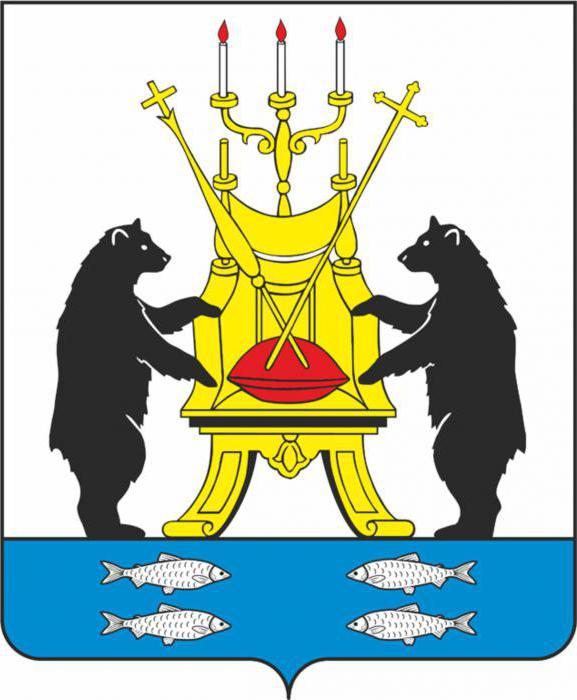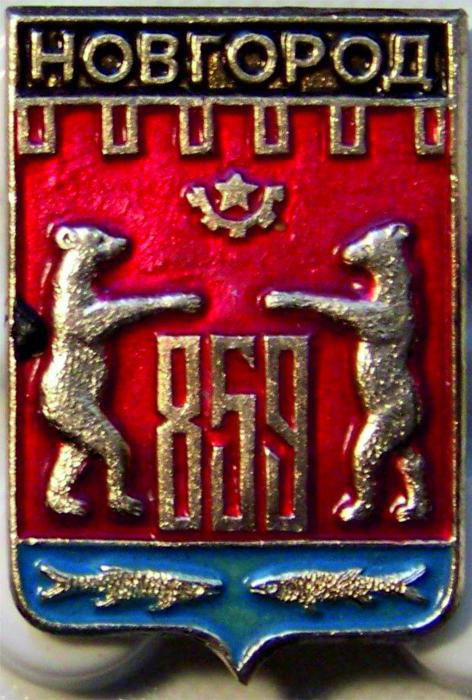The most ancient annalistic sources say: when the Varangian prince Rurik came to rule the lands of the ancient Slavs, there was already Great Novgorod. The emblem of this city is a source of real mysteries and inconsistencies, over the solution of which many generations of local historians and historians have been struggling.
Coats of arms have arisen since the appearance of the earliest Novgorod heraldic symbols.
Seals of the Novgorod Republic
In various seals that were used to fasten trade agreements between Novgorod merchants and foreign merchants and to approve treaties and decrees of the Novgorod Republic, five main images were used: Jesus Christ, the horseman, foot warrior, beast and bird. Among them there are no symbols that the modern coat of arms of Veliky Novgorod contains - a throne, two bears, fish.
For the first time, similar images appear after the final accession of Novgorod to the Moscow state during the time of Ivan the Terrible in the form of the seal of the Novgorod governor, made in 1565 at the behest of the tsar. In this form, it was also included in the Great Seal of Ivan IV. It is described as a “place”, on it is a staff, on the one hand is a bear, on the other is a lynx, below is a fish. The “place” in it is called the vechean “degree” - a tribune with steps that were addressed to the people during the citywide meetings of the Novgorod Republic.
Various interpretations
The complex and unusual symbolism, which contains the coat of arms of Veliky Novgorod, has several different interpretations. Not all researchers are satisfied with generally accepted explanations that the appearance of bears is associated with the existence among the pagans living on Novgorod lands of a cult of this beast, and fish symbolize the ancient crafts of people who lived on the shores of Lake Ilmen and the richness of its waters with different animals.
The opinion is known that the symbols depicted on the seal of Ivan IV are a threat to the Moscow Tsar to the freedom-loving Novgorodians. The staff, laid on the veche platform, means the supremacy of the central authority of the Moscow autocrat over the republican aspirations of the townspeople. Wild animals on the sides embody the power of the Moscow prince and punitive measures awaiting rebellious. Fishes symbolize water, where those who dare to fight for independence will be thrown. According to another version, fish as a symbol of Jesus is a testament to the support of imperial authority from higher powers.
Soon after the appearance of the Great Seal of Ivan the Terrible, events took place, according to some, confirming the correctness of those who interpret the Novgorod coat of arms in this way. Veliky Novgorod was accused of treason by the Moscow Tsar and subjected to brutal pacification.
“Titular” by Alexei Mikhailovich
In the famous monuments of Russian heraldry of the 17th century, a final modification of the Novgorod symbolism takes place, which led to the appearance of the final classical version. In the painting of the seals of Tsar Alexei Mikhailovich, the coat of arms of Veliky Novgorod is similar to the seal of the times of Ivan IV, but the lynx in it disappeared, replaced by a second bear.
The collection of heraldic symbols, which was presented to the father of Peter I - “Titular” of 1672 - for the first time shows a complete set of components of the Novgorod coat of arms. The stepped platform was transformed into a throne, on which lie a scepter, a cross and a candlestick, it is surrounded by two bears, below - two fish. This option differs from the modern one only in the turn of the throne (in three quarters). The coat of arms of Veliky Novgorod in the “Signed Stamp” of Minich (1730) shows the throne as now - in full face.
Historical coat of arms of the time of Catherine
The administrative reform of Empress Catherine II, during which the formation of provinces and governorates took place, was supported by the reorganization of the heraldic business. State symbols were brought into line with the requirements of the Herbology science and gained uniformity. The coat of arms of Veliky Novgorod, the description of which was supremely approved on August 16, 1781, took the form considered to be classical.

However, he mysteriously did not avoid mistakes. According to the heraldic laws, the colors used in coats of arms are divided into two types, called tinctures: metals and enamel (enamel). The first includes gold and silver, the second - scarlet (red), azure, black, purple, greens and some additional colors. The most important rule of tincture does not allow the placement of metal on metal, enamel on enamel, and exceptions should be clearly justified. The 1781 coat of arms description does not contain such an explanation, although the golden throne is located in a silver field.
Metamorphoses of the era of change
Soviet heraldry excluded from the arms any hints of monarchical and religious symbols. The coat of arms of Veliky Novgorod did not escape processing. Photos of urban symbols of those times show that the royal throne with the scepter and cross placed on it was removed from it. Two bears were located on either side of the number 859, meaning the official year of the founding of the city. The rule of tinctures was now respected, but the coat of arms lost touch with the centuries-old history of the ancient city.

The reconstruction of historical heraldic symbols began throughout the country with the beginning of a new Russian history. Veliky Novgorod also received them - the coat of arms and flag were developed on the basis of the classic version of the 18th century. At the same time, again there were some difficulties: in 2006, an option was approved, for some reason lacking the image of fish in the lower azure tip of the shield. Only in 2010, at the request of Novgorodians, fish were returned to the emblem of the city, and it acquired a canonical, historical appearance, preserving the old mysteries and secrets.